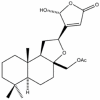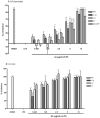In vitro and in vivo anti-inflammatory activity of 17-O-acetylacuminolide through the inhibition of cytokines, NF-κB translocation and IKKβ activity
- PMID: 21152019
- PMCID: PMC2995738
- DOI: 10.1371/journal.pone.0015105
In vitro and in vivo anti-inflammatory activity of 17-O-acetylacuminolide through the inhibition of cytokines, NF-κB translocation and IKKβ activity
Abstract
Background and purpose: 17-O-acetylacuminolide (AA), a diterpenoid labdane, was isolated for the first time from the plant species Neouvaria foetida. The anti-inflammatory effects of this compound were studied both in vitro and in vivo.
Experimental approach: Plant extracts were initially tested against LPS-stimulated release of tumor necrosis factor alpha (TNF-α) from murine macrophages (RAW264.7 cells). Based on bioassay-guided fractionation, the active compound was identified as AA. AA was tested for its ability to reduce nitric oxide (NO) production, and the inducible nitric oxide synthase (iNOS) expression. The inhibition of a panel of inflammatory cytokines (TNF, IL-1β, IL-6, KC, and GM-CSF) by AA was assessed at the expression and the mRNA levels. Moreover, the effect of AA on the translocation of the transcription factor nuclear factor kappa B (NF-κB) was evaluated in LPS-stimulated RAW264.7 cells and in TNF-stimulated L929 cells. Subsequently, AA was tested in the inhibitor of NF-κB kinase beta (IKKβ) activity assay. Lastly, the anti-inflammatory activity of AA in vivo was evaluated by testing TNF production in LPS-stimulated Balb/c mice.
Key results: AA effectively inhibited TNF-α release with an IC(50) of 2.7 µg/mL. Moreover, AA significantly inhibited both NO production and iNOS expression. It significantly and dose-dependently inhibited TNF and IL-1β proteins and mRNA expression; as well as IL-6 and KC proteins. Additionally, AA prevented the translocation of NF-κB in both cell lines; suggesting that it is acting at a post receptor level. This was confirmed by AA's ability to inhibit IKKβ activity, a kinase responsible for activating NF-κB, hence providing an insight on AA's mechanism of action. Finally, AA significantly reduced TNF production in vivo.
Conclusions and implications: This study presents the potential utilization of this compound, as a lead for the development of an anti-inflammatory drug.
Conflict of interest statement
Figures













Similar articles
-
Suppression of inflammatory responses by handelin, a guaianolide dimer from Chrysanthemum boreale, via downregulation of NF-κB signaling and pro-inflammatory cytokine production.J Nat Prod. 2014 Apr 25;77(4):917-24. doi: 10.1021/np4009877. Epub 2014 Apr 1. J Nat Prod. 2014. PMID: 24689881
-
Sulfuretin isolated from heartwood of Rhus verniciflua inhibits LPS-induced inducible nitric oxide synthase, cyclooxygenase-2, and pro-inflammatory cytokines expression via the down-regulation of NF-kappaB in RAW 264.7 murine macrophage cells.Int Immunopharmacol. 2010 Aug;10(8):943-50. doi: 10.1016/j.intimp.2010.05.007. Epub 2010 May 28. Int Immunopharmacol. 2010. PMID: 20546946
-
Immunomodulatory effects of 17-O-acetylacuminolide in RAW264.7 cells and HUVECs: involvement of MAPK and NF-κB pathways.Drug Des Devel Ther. 2014 Oct 20;8:1993-2007. doi: 10.2147/DDDT.S68659. eCollection 2014. Drug Des Devel Ther. 2014. PMID: 25349474 Free PMC article.
-
Acanthoic acid, unique potential pimaradiene diterpene isolated from Acanthopanax koreanum Nakai (Araliaceae): A review on its pharmacology, molecular mechanism, and structural modification.Phytochemistry. 2022 Aug;200:113247. doi: 10.1016/j.phytochem.2022.113247. Epub 2022 May 18. Phytochemistry. 2022. PMID: 35597316 Review.
-
Kirenol: A Potential Natural Lead Molecule for a New Drug Design, Development, and Therapy for Inflammation.Molecules. 2022 Jan 23;27(3):734. doi: 10.3390/molecules27030734. Molecules. 2022. PMID: 35163999 Free PMC article. Review.
Cited by
-
Gelam honey scavenges peroxynitrite during the immune response.Int J Mol Sci. 2012;13(9):12113-12129. doi: 10.3390/ijms130912113. Epub 2012 Sep 24. Int J Mol Sci. 2012. PMID: 23109904 Free PMC article.
-
Phytotherapeutic Analysis of Chloroform-Based Fractions of Alstonia scholaris and Wrightia tinctoria Extracts Reveals Potent Anti-Psoriatic Activity: An In Vitro and In Vivo Study.Pharmaceuticals (Basel). 2025 Feb 22;18(3):304. doi: 10.3390/ph18030304. Pharmaceuticals (Basel). 2025. PMID: 40143083 Free PMC article.
-
Chloroform Fraction of Centratherum anthelminticum (L.) Seed Inhibits Tumor Necrosis Factor Alpha and Exhibits Pleotropic Bioactivities: Inhibitory Role in Human Tumor Cells.Evid Based Complement Alternat Med. 2012;2012:627256. doi: 10.1155/2012/627256. Epub 2012 Feb 28. Evid Based Complement Alternat Med. 2012. PMID: 22474512 Free PMC article.
-
[Calenduloside E inhibits lipopolysaccharide-induced inflammatory response by inhibiting activation of ROS-mediated JAK1-stat3 signaling pathway in RAW264.7 cells].Nan Fang Yi Ke Da Xue Xue Bao. 2019 Aug 30;39(8):904-910. doi: 10.12122/j.issn.1673-4254.2019.08.05. Nan Fang Yi Ke Da Xue Xue Bao. 2019. PMID: 31511209 Free PMC article. Chinese.
-
Potential anti-inflammatory, antioxidant and antimicrobial activities of Sambucus australis.Pharm Biol. 2017 Dec;55(1):991-997. doi: 10.1080/13880209.2017.1285324. Pharm Biol. 2017. PMID: 28166708 Free PMC article.
References
-
- Medzhitov R. Origin and physiological roles of inflammation. Nature. 2008;454:428–435. - PubMed
-
- Serhan CN. Resolution Phase of Inflammation: Novel Endogenous Anti-Inflammatory and Proresolving Lipid Mediators and Pathways. Annu Rev Immunol. 2007;25:101–137. - PubMed
-
- Schett G. Rheumatoid arthritis: inflammation and bone loss. Wien Med Wochenschr. 2006;156:34–41. - PubMed
-
- Karin M, Greten FR. NF-kappaB: linking inflammation and immunity to cancer development and progression. Nat Rev Immunol. 2005;5:749–759. - PubMed
-
- Libby P, Ridker P, Maseri A. Inflammation and Atherosclerosis. Circulation. 2002;105:1135–1143. - PubMed
Publication types
MeSH terms
Substances
LinkOut - more resources
Full Text Sources

